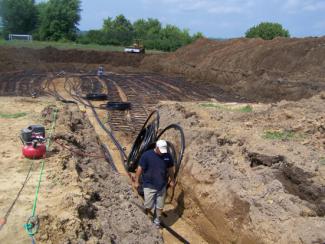Examples of communities saving energy and money with LED lighting just keep rolling in. Down in Winona County, the Ridgeway Community School utilized a CERTs Seed Grant back in 2014 to improve their lighting efficiency.
Ridgeway Community School is a public charter school serving the families of Pleasant Hill Township as well as the neighboring townships.
The lighting projects included:
- Identification and installation of quality LED lighting fixtures to replace 175 to 500 watt metal-halide wall packs on the exterior of the building. These wall packs run on photo-sensors and therefore operate between 10 and 15 hours per day.
- Replacement of 32 watt T-8 light bulbs in the school hallway with 25 watt T-8 lights. This is a more cost-effective upgrade for lights which are also on 10 to 15 hours per day as the LED fixtures that could replace the fluorescent fixtures use the same wattage that the existing fixtures will use when the 32 watt bulbs are replaced with 25 watt bulbs.
- Replacement of miscellaneous utility and storage room light bulbs with LED bulbs.
- The installation of 4 different 4 foot LED drop ceiling fixtures in the staff work room as a means of demonstrating the “look” of different drop ceiling LED lighting options.
- The installation of at least two different types occupancy sensors in rooms in which lights are regularly left on when no one is in them.
“LED lighting is really becoming the standard for our homes businesses and local institutions,” says Lissa Pawlisch, CERTs Director. “Moving forward with LED lighting can become the catalysis for a range of energy efficiency upgrades and we’re excited to have been able to support Ridgeway Community School.”
 Ridgeway was no stranger to energy efficiency. Back in 2007 the school did a major addition and renovation that included a new pre-engineered steel roof and insulation over the existing flat roof. At this time the school removed the 45 year old boiler and installed a ground-source water-furnace geothermal heating system which also supplies air conditioning. The school’s per square foot utility bills dropped substantially.
Ridgeway was no stranger to energy efficiency. Back in 2007 the school did a major addition and renovation that included a new pre-engineered steel roof and insulation over the existing flat roof. At this time the school removed the 45 year old boiler and installed a ground-source water-furnace geothermal heating system which also supplies air conditioning. The school’s per square foot utility bills dropped substantially.
Excerpt from story on the school by Rochester Post-Bulletin
If it didn’t make economic sense, Jodi Dansingburg would not have signed on.
Dansingburg, school coordinator for Ridgeway Community School, a public charter school serving the far corner or southeast Minnesota, said saving energy is, for her school, as much about saving money as the environmental impact.
“We are a small school, and the more we spend on electricity, the less we spend on things that directly affect the kids,” Dansingburg said. “Also, we wanted to demonstrate it. We were on the CERT (Clean Energy Resource Teams of Minnesota) tour and at open houses so the parents could see it.”
The school, located in the village of Ridgeway, serves 97 students in kindergarten through fifth grade plus 25 pre-kindergarten students mostly from rural townships but from as far away as Winona. A grant from the Clean Energy Resource Teams of Minnesota helped Ridgeway Community School make major changes to its lighting, which has saved the school money while it saves energy.
“It didn’t cover all of it, but a lot of it,” she said. “One of the big things we were able to get done was the lighting on the outside of the building.” Ridgeway replaced several high-intensity bulbs outside. “That was a pretty substantial savings,” Dansingburg said.
The school replaced 32-watt florescent bulbs with 25-watt bulbs, a move that saves the school 4,000 watts per hour. “We replaced probably two-thirds of the classroom lights,” Dansingburg said. The lower fluorescents would not save as much power as LEDs, but the LEDs were only four to five watts lower in power, so they were not financially worth the change. After testing with light meters, the school also took one bulb each out of several three-light fixtures to save additional power.
“Our estimated annual energy savings was 6,779 kilowatt hours,” Dansingburg said. That figure comes from the difference in power on the lights and the number of hours the school runs them.
In addition to the fluorescent lights, the school replaced some lighting with new LED bulbs and installed occupancy sensors in rooms that regularly are empty.
“Conservation is still the best investment as far as a return on your investment,” Dansingburg said. “The payback is faster that way. And there’s still so much out there that people can do.”
Click here to read the full article by Brian Todd >>


